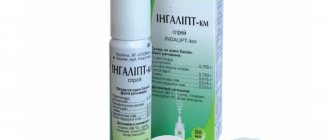Miramistin is a domestic local antiseptic. Miramistin during breastfeeding is used as an independent remedy and in complex therapy of various inflammatory diseases: nasopharynx, gynecological, dental, ARVI, runny nose and others.
A woman’s body after childbirth, during lactation, is weakened, immunity is reduced. In this situation, it is very important to help him cope with the disease without interrupting breastfeeding.
The purpose of our article is to figure out whether Miramistin can be used during lactation and in what situations it can be used.
Therapeutic effect of Miramistin:
- kills pathogenic viruses, bacteria, fungi;
- promotes regeneration of damaged tissues and mucous membranes;
- increases local immunity.
Miramistin for lactation in the throat and nose: indications for use
Often during breastfeeding, a runny nose, sore throat, sore throat, sore throat, toothache and other diseases begin to bother you, which require an effective and safe remedy to combat pathogenic bacteria and viruses. At the first symptoms, the mother of the child must take measures so as not to get sick herself and not to infect the baby. In many cases, Miramistin will be an effective medicine during lactation. For what ENT diseases will it help, and when will it be useless?
Diseases of the throat and nose that Miramistin treats during breastfeeding:
- angina;
- pharyngitis;
- laryngitis;
- rhinitis;
- frontal sinusitis;
- sinusitis;
- sinusitis;
- sore throat;
- laryngeal candidiasis;
- herpetic stomatitis;
- removal of a tooth;
- flux;
- gingivitis;
- periodontal disease;
- herpes in the nose and oral mucosa.
These diseases can be present in a nursing woman in both acute and chronic forms. Miramistin during lactation in the nose for sinusitis and sinusitis is used in a hospital setting for rinsing the nasal sinuses.
In other cases, self-medication with the drug is possible in compliance with the dosage and regimen. But it’s still better to discuss treatment with your doctor.
When breastfeeding, it is important for mothers to treat diseases in a timely manner so as not to expose the baby to infection. When breastfeeding, treatment with Miramistin consists of treating the oral cavity with it and irrigating or instilling the nose.
Treatment of wounds and stitches
For deep wounds and cracks, use ointment - apply a generous layer and leave for 6-8 hours. Before feeding, rinse your breasts with boiled water and wash with soapy water to prevent the product from entering the baby’s body.
Cracked nipples
Miramistin, compared to its analogues, not only has an antiseptic effect, but also activates the body's defenses, promotes tissue regeneration at the cellular level, and eliminates pain in the problem area.
Breastfeeding women should note that the drug should be used at the first sign of illness. The use of Miramistin will help to quickly suppress the activity of pathogenic microorganisms and speed up the healing process.
The method of using the drug depends on the form of release and diagnosis. Before using Miramistin, a nursing mother should definitely consult her doctor. He will determine the dosage and duration of therapy, and will also decide whether it is preferable to prescribe an ointment or a solution.
Treatment of gynecological diseases and inflammation of the female genital organs
- treatment of the oral cavity in the treatment of dental problems;
- combating fungal infections of the skin and mucous membranes;
- rapid healing of wounds, burns, postoperative sutures, including after cesarean section, as well as cracked nipples;
- prevention and treatment of postpartum injuries and infections, inflammatory diseases of the vagina;
- treatment of chronic otitis, tonsillitis and other diseases of the ENT organs;
- elimination of candidiasis (thrush) in the vagina, corners of the mouth, oral cavity, and nipples.
Antiseptics are an integral part of a home first aid kit. One of the effective broad-spectrum drugs is Miramistin. However, during lactation, many medications are not recommended for use, so women often ask whether it is safe to use when breastfeeding.
Miramistin for breastfeeding in the throat: instructions
Miramistin for breastfeeding in the throat can be used in two forms.
A solution or spray is suitable for treatment. The throat spray is available in the form of a colorless, odorless and tasteless liquid in a volume of 150 ml. Sold complete with a spray nozzle for irrigating the throat. The pharmacy chain sells the medicine without a prescription.
Miramistin during lactation in the throat will help with inflammatory diseases of the mouth, throat and larynx, and dental diseases.
Gargle or irrigate the throat with a medicinal product using a nozzle. The procedure must be performed at least 3 times a day. To rinse with Miramistin, use 10-15 ml of the drug.
Throat irrigation algorithm:
- Replace the cap on the medicine bottle with a spray nozzle.
- By pressing the nozzle, make 3-4 irrigations of the oral cavity. It is more effective to spray the medicine into different parts of the throat: to the right and left, irrigating both tonsils and in the center, directing the stream to the back wall of the pharynx.
- Carry out the procedure 3-5 times a day.
Algorithm for gargling with Miramistin:
- Repeat rinsing 3-5 times a day.
- Do not drink or eat food for half an hour.
- Spit out the solution.
- Gargle for 1 minute.
- Tilt your head back so that the solution evenly irrigates your mouth and throat.
- Measure the required volume of the drug; to do this, pour the solution into a tablespoon.
- Do not swallow the medicine during the procedure.
- Miramistin for gargling does not need to be diluted with water.
- Rinse after eating.
- Do not use Miramistin for rinsing for more than 10 days, this will lead to dysbacteriosis of the oral cavity.
Miramistin for the throat during breastfeeding is a safe and effective remedy, but it is usually used in complex therapy.
Miramistin during lactation in the nose: method of application
A runny nose is one of the common symptoms of ARVI. A runny nose must be treated to prevent complications such as sinusitis or sinusitis.
To eliminate a runny nose, Miramistin is used during lactation, by instillation into the nose or its irrigation. The drug kills viruses and bacteria, and also creates a protective film on the mucous membrane. Miramistin for instillation into the nose has only one drawback - for a short time it can cause a slight tingling sensation. For the nose, it is better to purchase a dropper bottle or irrigate using a nozzle, which is not very convenient.
How to instill Miramistin in your nose:
- Rinse your nose before using saline solution.
- Place 2 drops of Miramistin into each nasal passage.
- Repeat instillation 2-3 more times per day
How to irrigate your nose with Miramistin:
- Prepare a spray with a nozzle.
- Spray the medicine 1-2 times into each nostril.
- Do the procedure no more than 3 times a day.
How to rinse your nose with Miramistin:
- Dilute the product with boiled salted water (or saline) in a ratio of 1:2
- Draw the diluted solution into a syringe without a needle.
- Tilt your head to the side and pour into one nostril so that it flows freely from the other.
- Repeat with the other nasal passage as well.
Miramistin can also be used for prevention during lactation by instilling or irrigating the nose once a day.
Composition of the drug, therapeutic effect
Miramistin is also used for gargling. To do this, pour a small amount of Miramistin, namely a tablespoon, into a glass and gargle. You can repeat this procedure 3-4 times a day after meals for no more than 1 minute for 10 days. The duration of treatment must be agreed with the doctor. You can eat food no less than half an hour after irrigation. You should not swallow the solution .
Clinical studies, safety profile
Despite the fact that all these drugs have a high safety profile, we must not forget about possible individual intolerance to the drugs. Therefore, it is important to observe the baby’s reaction. If any negative reactions occur, the use of antiseptics should be stopped and consult a doctor.
A runny nose is one of the common symptoms of ARVI. A runny nose must be treated to prevent complications such as sinusitis or sinusitis.
The method of using the drug depends on the form of release and diagnosis. Before using Miramistin, a nursing mother should definitely consult her doctor. He will determine the dosage and duration of therapy, and will also decide whether it is preferable to prescribe an ointment or a solution.

Treatment of gynecological diseases and inflammation of the female genital organs
Chlorhexidine is often considered an analogue of Miramistin for diseases of the nose and throat, but the former has an undoubted advantage during lactation. Miramistin is safe when feeding; it is not absorbed through the mucous membrane of the nose and throat, and does not pass into breast milk. It has no contraindications during lactation; it is also used to treat pregnant women and infants.
- Viral infection. The most common cause of pharyngitis is inflammation of the laryngeal mucosa. Requires symptomatic treatment and usually goes away in 5-10 days.
- Bacterial infection. The main cause of acute tonsillitis (tonsillitis). The disease is accompanied by inflammation of the tonsils and throat mucosa. Treatment is carried out with antibiotics.
- Fungal infection. Candidiasis or thrush most often appears in infants, but sometimes occurs in adults. Treatment requires antifungal agents.
- Allergy. During pregnancy and breastfeeding, a woman's body becomes more sensitive. Treatment requires antihistamines and avoidance of contact with allergens.
Some old-school pediatricians answer negatively to the question of whether it is possible to breastfeed if you have a sore throat. You can still hear recommendations to stop breastfeeding and temporarily switch the baby to formula.
In the vagina
When applying the drug to the skin or mucous membranes, a slight burning sensation may occur for 20 - 30 seconds. This should not be alarming; this effect is considered normal and is not an indication for discontinuing the use of the medicine.
Antiseptics are an integral part of a home first aid kit. One of the effective broad-spectrum drugs is Miramistin. However, during lactation, many medications are not recommended for use, so women often ask whether it is safe to use when breastfeeding.
Miramistin during breastfeeding: does it help?
As patient reviews and doctors' prescriptions show, in otorhinolaryngology, Miramistin is successfully used when feeding a child to treat inflammatory diseases of the nasopharynx.
It is more convenient to use Miramistin in the throat when breastfeeding in the form of a sprayer, and for irrigating the nose it is better to use nasal sprays specially designed for this purpose, with a more convenient nozzle.
They spray the product evenly with a fine dispersion, and it settles better on the mucous membrane of the nasal passages (for example, Kameton).
A comparison of nasal rinsing techniques that can be used for rinsing with Miramistin for a runny nose is in the following video.
Contraindications and side effects
Miramistin has a high safety profile. The only contraindication for use is individual intolerance to the drug. A mild burning sensation may occur at the application sites, which will subside within ten to fifteen seconds. In rare cases, a local allergic reaction may occur. Also, some dentists do not recommend using Miramistin solution for more than ten days, as dysbacteriosis may develop in the oral cavity. There are no other data on cases of drug overdose.

obstetrics and gynecology
Since Miramistin is a widely used drug, the choice of method, frequency, and duration of use depend on the type and severity of the disease. Despite the safety of the medication, treatment with this antiseptic should be agreed with a doctor. Miramistin as an adjuvant enhances the effect of antibiotics, antiviral and antifungal drugs.
Taking Miramistin while feeding a child is prescribed in the event of an inflammatory process in a woman’s body. There is no need to stop the breastfeeding process, since the medicine is harmless, there is practically no resorption of the drug.











